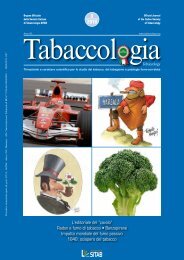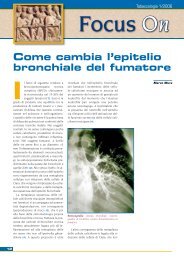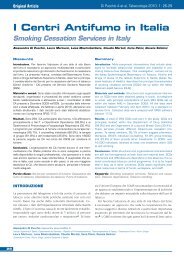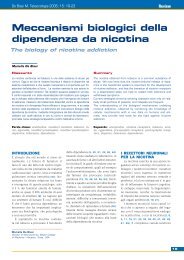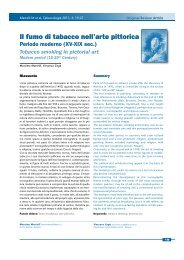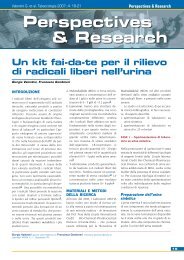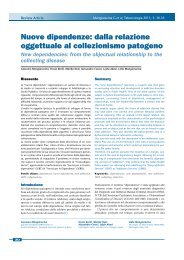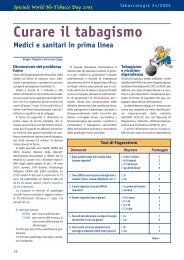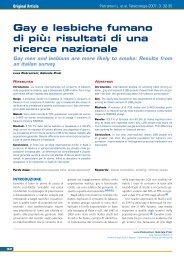Scarica n. 3/2003 - Società Italiana di Tabaccologia
Scarica n. 3/2003 - Società Italiana di Tabaccologia
Scarica n. 3/2003 - Società Italiana di Tabaccologia
Create successful ePaper yourself
Turn your PDF publications into a flip-book with our unique Google optimized e-Paper software.
<strong>Tabaccologia</strong> 3/<strong>2003</strong><br />
derate in questo report è limitato a quelle<br />
patologie per le quali erano <strong>di</strong>sponibili<br />
i dati ed alle malattie per le quali la US<br />
Surgeon General ha implicato il fumo<br />
come causa. Altre malattie acute e croniche<br />
influenzano la qualità <strong>di</strong> vita e sono<br />
causate dal fumo <strong>di</strong> sigaretta. La inclusione<br />
<strong>di</strong> queste malattie aumenterebbe la<br />
quota <strong>di</strong> morbilità attribuibile al fumo.<br />
I risultati <strong>di</strong> questo report completano<br />
comunque i dati sulla mortalità del CDC<br />
e le stime sul numero <strong>di</strong> adulti affetti da<br />
malattie croniche causate dal fumo. Circa<br />
il 10% <strong>di</strong> tutti i fumatori correnti ed exfumatori<br />
presentano una malattia cronica<br />
attribuibile al fumo. Molte <strong>di</strong> queste<br />
persone stanno già vivendo una <strong>di</strong>minuzione<br />
della qualità <strong>di</strong> vita, e la società<br />
dovrà sostenere i costi <strong>di</strong>retti ed in<strong>di</strong>retti<br />
<strong>di</strong> queste patologie. Sempre più persone<br />
dovranno sopportare malattie croniche<br />
legate al fumo, se continuano a fumare.<br />
Questo report sottostima però la necessità<br />
<strong>di</strong> adottare strategie efficaci per<br />
<strong>di</strong>minuire il consumo <strong>di</strong> tabacco, come<br />
aumentare il costo delle sigarette,<br />
migliorare l'aria degli ambienti chiusi,<br />
come quelli <strong>di</strong> lavoro e <strong>di</strong> ristoro, promuovere<br />
campagne <strong>di</strong> prevenzione e<br />
cessazione del fumo. (MMWR)<br />
(Traduzione a cura <strong>di</strong> Marco Mura)<br />
Bibliografia:<br />
1. CDC. Reducing the health consequences of<br />
smoking: 25 years of progress---a report of the<br />
Surgeon General. Rockville, Maryland: U.S.<br />
Department of Health and Human Services,<br />
CDC, 1989; DHHS publication no. (CDC) 89-8411.<br />
CDC. Annual smoking-attributable mortality,<br />
years of potential life lost, and economic costs---<br />
United States,1995--1999.MMWR 2002;51:300--3.<br />
2. Walter SD. Calculation of attributable risks<br />
from epidemiologic data. Int J Epidemiol<br />
1978;7:175--82.<br />
3. Winer BJ, Brown DR, Michels KM. Statistical<br />
principles in experimental design, 3rd ed. New<br />
York, New York: McGraw-Hill, 1991.<br />
4. Thun MJ, Apicella LF, Henley SJ. Smoking vs<br />
other risk factors as the cause of smoking-attributable<br />
deaths. JAMA 2000;284:706--12.<br />
5. Baker M, Stabile M, Deri C. What do self-reported,<br />
objective, measures of health measure?<br />
Cambridge, Massachusetts: National Bureau of<br />
Economic Research, 2001; NBER working paper<br />
no. 8419.<br />
6. Mannino DM, Gagnon RC, Petty TL, Ly<strong>di</strong>ck E.<br />
Obstructive lung <strong>di</strong>sease and low lung function<br />
in adults in the United States: data from the<br />
National Health and Nutrition Examination Survey,<br />
1988--1994. Arch Intern Med<br />
2000;160:1683--9.<br />
7. Peto R, Lopez AD, Boreham J,Thun M, Heath C.<br />
Mortality from smoking in developed countries<br />
1950--2000. In<strong>di</strong>rect estimates from national<br />
vital statistics. Oxford, United Kingdom: Oxford<br />
University Press, 1994<br />
Michela Bagnalasta<br />
Ricercatrice clinica, GSK S.p.A.<br />
Abstract & Commentary<br />
Il fumo e le donne...<br />
Quando decidono<br />
<strong>di</strong> smettere<br />
1. Perkins, K, et al., Sex <strong>di</strong>fferences in the subjective and reinforcing affects of visual and<br />
olfactory cigarette smoking stimuli. Nicotine & Tobacco Research 3 (2): 141-150, 2001.<br />
2. Perkins, K., et al., Cognitive-behavioral therapy to reduce weight concerns improves smoking<br />
cessation outcome in weight-concerned women. Journal of Consulting and Clinical Psychology<br />
69(4): 604-613, 2001.<br />
3. Perkins, K.A., Levine, M., and Marcus, M., Tobacco withdrawal in women and menstrual cycle<br />
phase. Journal of Consulting and Clinical Psychology 68(1): 176-180, 2000.<br />
Proclamare l' "Uguaglianza fra i Sessi" non è più <strong>di</strong> moda! Per lo meno<br />
nel campo <strong>di</strong> ricerca sul fumo! Il gruppo <strong>di</strong> Ken Perkins <strong>di</strong> Pittsburgh,<br />
ha pubblicato tre lavori seguendo un razionale basato sulla <strong>di</strong>fferenza<br />
fra i sessi e l'impatto che questa può avere sul comportamento del<br />
fumatore. I tre stu<strong>di</strong> analizzano tre <strong>di</strong>versi fattori che si sono rivelati utili<br />
nell'indurre e facilitare le donne a smettere <strong>di</strong> fumare e nel prolungare<br />
il loro periodo <strong>di</strong> astinenza da fumo.<br />
Gusto ed olfatto. Il primo stu<strong>di</strong>o analizza l'importanza dei "fattori sensoriali" ed evidenzia<br />
come il gusto e l'odore della sigaretta giochino un ruolo fondamentale nel<br />
comportamento del fumatore "femmina". Allo stu<strong>di</strong>o hanno partecipato fumatori <strong>di</strong><br />
entrambi i sessi; i meto<strong>di</strong> <strong>di</strong> valutazione sono stati il rinforzo al fumo (misurato come<br />
numero <strong>di</strong> aspirazioni in <strong>di</strong>verse situazioni) ed il piacere derivato dal fumare in quelle<br />
determinate situazioni. Bloccando gli stimoli sensoriali e fumando in questa con<strong>di</strong>zione,<br />
le donne percepiscono un piacere significativamente inferiore rispetto agli<br />
uomini. Questo stu<strong>di</strong>o apre nuove prospettive <strong>di</strong> ricerca basate su altri rinforzi<br />
con<strong>di</strong>zionati del fumatore: marca della sigaretta, gestualità "mano-bocca",<br />
contesti ambientali e consumo <strong>di</strong> altre sostanze (come caffeina o alcol).<br />
Interessante sarà correlare l'importanza dei <strong>di</strong>versi rinforzi con<strong>di</strong>zionati<br />
con il sesso del fumatore per determinare ciò che è più efficace<br />
per gli uomini e per le donne. (1)<br />
Qualche chilo è concesso. Il temuto "aumento <strong>di</strong> peso" da<br />
parte delle donne come conseguenza dello smettere <strong>di</strong> fumare<br />
è l'oggetto del secondo stu<strong>di</strong>o condotto dal gruppo <strong>di</strong><br />
Perkins. L'aumento <strong>di</strong> peso si è rivelato determinante nell'indurre<br />
molte donne a ricadere una volta smesso <strong>di</strong> fumare,<br />
o ad<strong>di</strong>rittura a non tentare <strong>di</strong> smettere per non<br />
incorrere in questo problema. Una <strong>di</strong>eta mirata a<br />
prevenire questo aumento <strong>di</strong> peso si è rivelata<br />
essere non solo poco efficace dal<br />
punto <strong>di</strong> vista dei "chili", ma ha anche<br />
influito negativamente sulla motivazione<br />
a smettere <strong>di</strong> fumare. In questo<br />
stu<strong>di</strong>o clinico, 219 donne intenzio-<br />
31



